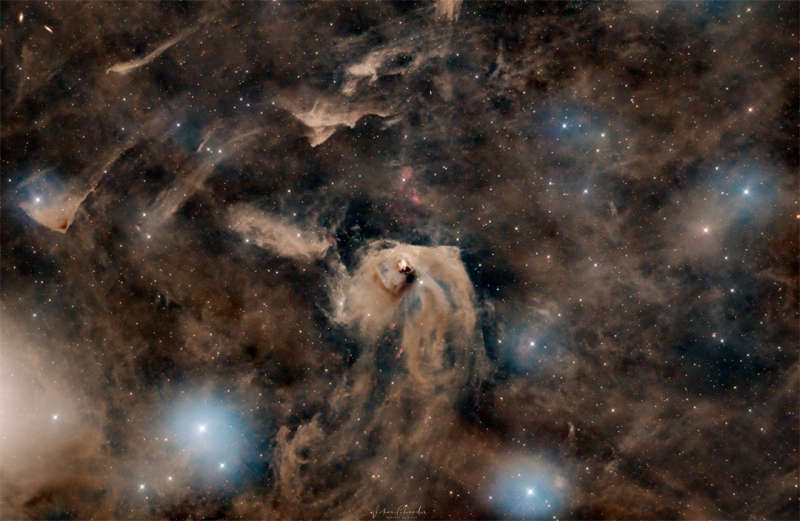
|
Credit & Copyright: Vikas Chander
Explanation:
Can dust be beautiful?
Yes, and it can also be useful.
The Taurus molecular cloud has several bright stars,
but it is the
dark dust that really
draws
attention.
The pervasive
dust
has waves and ripples and makes picturesque
dust
bunnies,
but perhaps more importantly, it marks regions where
interstellar gas is dense enough to
gravitationally contract to form stars.
In the image center is a light cloud lit by
neighboring stars that is home not only to a famous nebula,
but to a very young and massive famous star.
Both the star,
T Tauri, and the nebula,
Hind's Variable Nebula,
are seen to vary dramatically in brightness --
but not necessarily at the same time, adding to the mystery of this intriguing region.
T Tauri and
similar stars
are now generally recognized to be
Sun-like stars that are less than a few million years old
and so still in the early stages of
formation.
The featured image spans about four
degrees
not far from the
Pleiades star cluster,
while the featured dust field lies about 400
light-years away.
|
January February March April May June July August September October November December |
| ||||||||||||||||||||||||||||||||||||||||||||||||
NASA Web Site Statements, Warnings, and Disclaimers
NASA Official: Jay Norris. Specific rights apply.
A service of: LHEA at NASA / GSFC
& Michigan Tech. U.
Based on Astronomy Picture
Of the Day
Publications with keywords: Taurus - star formation
Publications with words: Taurus - star formation
See also:
- APOD: 2025 December 9 Á The Heart of the Soul Nebula
- APOD: 2025 July 10 Á Lynds Dark Nebula 1251
- APOD: 2025 June 23 Á W5: Pillars of Star Formation
- APOD: 2025 April 28 Á Gum 37 and the Southern Tadpoles
- APOD: 2025 March 26 Á Star Formation in the Pacman Nebula
- Young Stars, Dark Nebulae
- APOD: 2024 October 22 Á M16: Pillars of Star Creation
